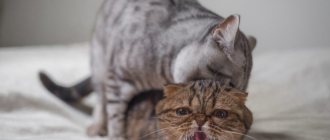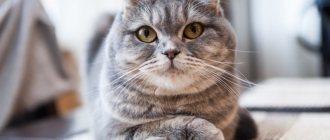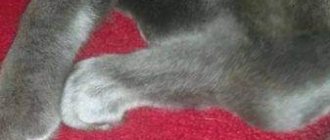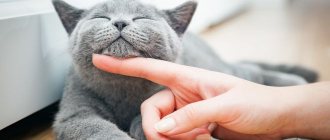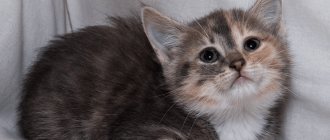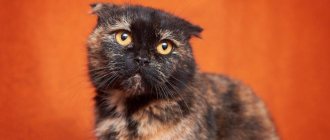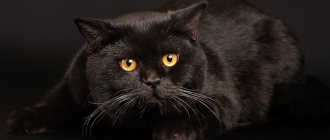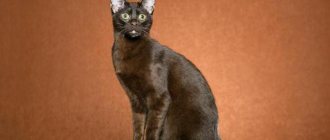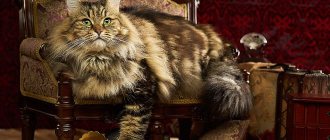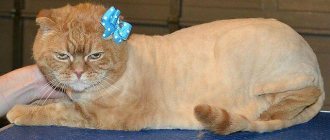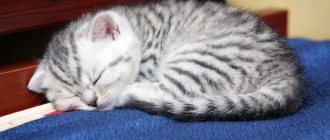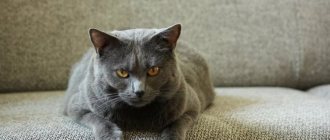Almost all lovers of such pets know the color of color point cats, thanks to the Siamese and Thai breeds. That is why it is quite often confused. But these are not all types of cats that have such an attractive color of their fur. In some distant countries this color may also be called Himalayan. Cats of these breeds are often affectionate and cannot be alone.
Color Description
If translated from English, “color” means color, and “point” means a point. Points are small dark spots located on the face, tail, paws and ears.
The usual color of a cat is solid. The pigment is evenly distributed throughout the animal’s fur and body. Therefore, you can see the uniform color of the pet.
For a color point cat, everything is completely different. Their DNA contains the cs gene, thanks to which the pigment enters only the peripheral parts of the body, that is, the cold ones. They are located at a relative distance from the warm ones. Such areas are the ears, tail, paws and muzzle.
In other parts of the body, where the temperature is relatively higher, the pigment is not able to manifest itself actively. Scientifically this is called acromelanism .
As a result, the pet’s body is painted a lighter color than the rest of the body. The overall color tone remains uniform, but only changes in its saturation and intensity. The more pronounced the border between light and dark coats is, the higher the value of such a cat for exhibition work.
Dark pigmentation can be more than just brown. There are also these colors:
Based on this, individual varieties are distinguished, for example, seal point, red point, blue point, etc. Certain breeds can combine several shades at once.
Features of color
The color point cat breed is no longer some kind of exotic. Every year such pets are becoming increasingly popular. But they still have certain features:
- Color point kittens are always born only in light shades. Only after a few days do the first pigment spots begin to appear on the paws, tail, and then on the face. This is due to the fact that during intrauterine development the kittens were exposed to constant warm temperatures. After birth and exposure to a colder environment, the coloring pigment begins to activate, which entails darkening of certain areas of the body.
- The appearance of a point kitten can only be guaranteed if both of its parents also have a pigmented color. But sometimes there are exceptions. One or even both parents can have a solid coat, but be carriers of the cs gene, which is responsible for darkening the peripheral areas of the body. In this case, some kittens will turn out to be pointing.
- The intensity of the color difference depends on the temperature in which the animal is located. The lower it is, the darker and richer the pigment areas will be.
- The cs gene is directly related to the color of the pet's eyes, which must be blue. In this case, the breed does not matter. The brighter and more saturated the color, the better the color of the animal appears.
It must be remembered that cats kept in cool conditions may completely lose their unique color. The ideal temperature for such breeds is from +25 degrees Celsius.
Solid (solid)
Monochrome is considered a classic color scheme. The coat has a uniform toning of the same shade. Since British cats took part in the development of the Scottish Fold breed, the fur coat often acquired a blue or gray color. Moreover, the animals had amber pupils of their eyes.
Blue solid
Various combinations of dominant and recessive genes have led to the emergence of other solid color options:
- ebony (black);
- cinnamon (milk chocolate);
- brown (chocolate);
- faun (deer);
- red (red);
- peach (cream);
- lilac (pale gray);
- white.
In the photo there is a black Scottish fold cat (ebony)
Eye color often directly depends on the color of the coat. White folds have predominantly blue or multi-colored pupils. Lilac and black Scots typically have bright yellow or copper-colored eyes. The amber look is characteristic of chocolate-colored Scottish dogs.
Main breeds
Thai and Siamese cat breeds are precisely those that have the color point pigment initially. This is implied by the standard. But there are other types. In addition to plain coats, they also have point subspecies. These include:
- Persian. This is the first breed that has been successfully turned into a pointing breed, with the exception of the Siamese. The Point Persian was created by mating a Siamese cat with an ordinary Persian cat. But there is also a small minus for the owners - a lot of attention must be paid to the luxurious fur of these pets.
- British colorpoint cats. This is a separate subspecies of ordinary Britons, which was first bred not so long ago. Breeding them is quite a difficult task, so babies of this breed are highly valued.
- Scottish straight. Representatives of this breed have darkened areas that look like a light haze. It was possible to breed by mating the best specimens of the British and Persians. These are very beautiful cats, and they also have a soft and flexible character.
- Neva Masquerade. These are Siberian cats with pigment coloring. They were first bred by St. Petersburg breeders by crossing Siberians and Siamese. The artificially bred breed is extremely beautiful. Its representatives have a rather large body with a very thick coat, which was inherited from their Siberian ancestors. It goes well with the colors of the Siamese, as well as the deep blue eyes.
- This coloring is found in all breeds of sphinxes, for example, Canadian or Peterbalds. They have point coloring on their skin, since the fur is completely or almost completely absent.
This is not the entire list of breeds with this coat color. There are also very rare ones, for example, snowshoe or Burmese. But they are not yet very common in the world.
Scottish Highland Straight
The Scottish Highland Straight is a subspecies of the Scottish cat. It is distinguished by the fact that it has long hair and erect ears. This variety has an unusual color. They brought her out in the 70s. years of the last century, when the British crossed with the Persians. Kittens from these breeds were able to get only the best. They have a very calm and friendly character, as well as a cute appearance. Highland Straights are easy to maintain. There is also a tortoiseshell variety, which also has a point color. Description of the breed:
- Quite long coat that is very easy to comb. Has a relatively dense undercoat.
- The ears are small in size with rounded tips and stand erect.
- The eyes are large and round in shape. Color may vary. He is completely dependent on wool.
- The body is strong, muscular, of medium size. Often these cats have a round shape.
- The toes are quite tightly clenched. The limbs themselves are long.
- The head is round and has a convex skull.
- Average tail length. He is very fluffy and active.
- These cats live from 10 to 20 years.
- The average weight of animals is 3.5 kg, and that of a cat is 5 kg.
- Standard length is 30 cm.
Character of color point
The character of the color point is always very cheerful . These cats are quite energetic and have taken all the best habits from their Siamese ancestors. In some cases, they are jealous of their owners, and may also be offended that they are given too little attention. But still, cats are not at all aggressive and make excellent contact not only with people, but also with other animals that are in the apartment.
They are also distinguished by a certain obstinacy. It is better not to offend such a breed, because cats will remember everything in the future. But when a pet is surrounded by love and care, it will be a very loyal friend.
This breed will appeal to those who rarely leave their cozy apartment for a long time. Colorpoint cats need constant attention from their owner. They want to be involved in a person's life. Pets will be happy to crawl under the blanket or jump on your lap and wait to be petted. The cat will immediately begin to purr contentedly.
Origin story
I would like to immediately clarify the issue of the origin of Scottish Straights. This is the name of the second line of the Scottish cat breed. A Scottish Fold cat's litter may include straight-eared Scottish Straights and fold-eared Scottish Folds. The line was fixed because crossing Scottish Folds with other felines did not give the desired result - stunted, sick offspring were born, with genetic diseases of the musculoskeletal system. Only straights helped to successfully fix the lop ear gene and improve the genetic material.
Due to this dependence of the lines on each other, some time ago the Scottish Strat was recognized as a breed. Moreover, they are really quite different from Scottish Folds in character and temperament.
Difficulties in selecting a pair for the reproduction of lop ears make both breeds inextricably linked. We can say that the Scottish Straight is the other side of the coin of the Scottish Fold cat, in no way inferior to them in beauty and intelligence.
Maintenance and care
Almost all breeds with this color are more valuable when the contrast between the base color and the pigment parts is strong. Therefore, the main task of a person is to maintain the correct color. In addition to temperature, other factors also affect color.
The first one is age. Almost every cat darkens over time . The pet’s diet can also greatly affect the color. An indisputable fact is that carrots and seaweed, which contain a lot of iodine, can change the color of an animal. You should be careful about the composition of the feed. It is not advisable to give your cat vitamins that contain seaweed and kelp. You should not feed foods containing a lot of copper.
Experts have noticed that Thais begin to quickly turn dark when eating beef, any seafood, liver and buckwheat. If there is a predisposition, then the best solution would be to use special feed.
Any damage can also change the color of fur and even skin. In areas where injury or surgery has been performed, the fur will be much darker. This is due to the fact that that area of the body will become much colder. In some cases, color may return after the first molt, but this does not always happen.
If you definitely need to have surgery, then it is advisable to choose a place that will be least noticeable. After the procedure, it is necessary to carefully wrap the incision until complete healing.
We must not forget about trimming the claws. This should be done so that the pet cannot hurt itself.
Owner reviews
I could never imagine my life without some animals. I always considered everyone I had as part of the family. The cat was bought about 5 years ago. He was about a month old then. He didn’t even know how to feed himself or go to the toilet yet. Most likely, the seller needed to sell the cat as quickly as possible, so he lied a little about the baby’s readiness for independent life. In general, the kitten was named Bonya.
Color point cats are very cute and gentle kittens, and adult cats too. They are quite interesting to watch. They are funny, active and cheerful.
We bought a British Shorthair as an adult. At that time she was 10 months old. She is very clingy by nature and loves a lot of human attention. She herself jumps into her arms, but only in those cases when she exactly wants it. You can squeeze for hours, the cat is very patient.
We have a Sphynx Peterbald cat. They set up a special place for her to sleep, but she only sleeps there during the day. At night he always comes to my bed.
Feeding
An adult cat is fed 2-3 times a day. The Scottish Straight diet consists mainly of protein foods:
- lean boiled meat (beef, chicken, turkey);
- boiled sea fish without bones (given twice a week);
- fermented milk products (sour cream, cottage cheese, unsweetened yoghurt and even cheese, but you should not give it often or a lot, the cat may develop intestinal upset);
- various porridges with meat broths;
- vitamin supplements.
When choosing vitamins for a cat, you should seek advice from experienced breeders or a veterinarian; Scottish Straight cats are prescribed calcium with caution. According to reviews from breeders, it is better for kittens to choose a balanced specialized food for feeding, which already contains the additives necessary for an active and fulfilling life
According to reviews from breeders, it is better for kittens to choose a balanced specialized food for feeding, which already contains the additives necessary for an active and fulfilling life.
The straight-eared side of the Scottish medal is an unexpected surprise for cat fans. A smart, intelligent and well-mannered cat is an undoubted blessing for constantly busy owners.
Standard color point color
With the correct color point color, the color of British cats should be high-contrast and bright. There is a clear boundary between the light-colored body, darkened paws, muzzle, and ears. Residual patterns and spots on the body are considered defective.
The British colorpoint are the owners of very beautiful eyes - blue or blue, and the saturation of the shade is most valued. A genetic feature of color points is the low production of melanin, which determines the only eye color. This is the uniqueness of this color relative to others.
Color Point Britons have another alternative name - Siamese Britons. They have dense hair and a white undercoat.
Genetics color point
The hairs and eyes of British Color Point kittens are filled with color due to melanin. Its production occurs under the influence of tyrosinase (enzyme) on the amino acid tyrosine. Tyrosinase works under the control of the C - color gene, which determines what shade the eyes and hairs will be. In the case of gene C mutation, the production of active tyrosinase is blocked, which prevents the appearance of pigment. In this situation, an albino animal with bleached fur will be born. A lowercase letter “c” is used to designate a mutant gene.
Wool changes its color when exposed to different temperatures. The principle “the warmer, the brighter” works here. Thus, the color of the muzzle, ears, front and hind limbs, and tail is darker relative to the body. The cs gene is responsible for the manifestation of the Siamese coat coloring, allowing the pigment to penetrate the hairs only on parts of the body at a lower temperature.
Fun fact: Newborn Siamese kittens (British Color Point kittens) have a completely light coat color because the environment in the womb is warm. The final color will be established at the age of 6-10 months.
The recessiveness of the cs gene will allow it to appear in the offspring only if it is present in the genotype of both producers. To do this, producers do not have to be colorpointed; it is enough to be carriers of the gene.
How to choose a kitten
Scottish straight kittens are just as adorable as fold kittens. Before buying a baby, study the breed standard and choose a nursery with a license to breed Scots.
Healthy Scottish cats smell pleasant, have lush and shiny fur, clear expressive eyes, a soft, non-bloated belly, and clean fur under the tail.
Trouble-free kids willingly join in the game and show a keen interest in strangers. Lethargic kittens are most likely sick with something.
Observe the character of the parent couple. This will help you understand what traits the kittens will inherit.
color-point groups
The activity of the point color gene is activated when it is present in two sires. Scientific research has revealed that individuals of this color are partly albinos. At birth they have a snow-white coat color, which later turns into color point. In the first month of life, the ears darken, a month later - the nose, and then the entire muzzle. Dark spots should be intense, contrasting relative to the body.
Color changes when exposed to heat or cold. To maintain purity and uniformity of color, such animals require warm conditions.
Solid colors
Solid color point varieties are widespread among furry representatives of the British breed. Owners of the classic color point have a very light body framed by areas of the main color.
The fur is short, with a dense structure. The correct color is contrasting, the hairs in dark areas are evenly colored. The color of the point marks is clear, intense, no blurring, no dyed white hairs. The point markings, nose, and pads on the limbs are characterized by a single color.
Offspring with a solid color point in British and Scottish cats can only be obtained from sires with this coat color or from carriers of the corresponding gene. It is also important for older ancestors to be solid color point or have a gene for this color in their genotype and the ancestors of both parents should have it. As mentioned earlier, newborn kittens do not have point markings. Darkening appears on the limbs, tail, ears, and muzzle later. It is interesting that the intensity of the shade of point marks in British cats depends on their age; in more mature individuals, the color is more saturated in tone.
The varieties are shown in the table.
| A variety of solid point | BRI code | Body tone | Point marks | Eyes | Tone of paw pads, nose mirrors |
| Black | seal point | Seal-point | n 33 | Warm white, light beige, beige, cream | Dark brown | Light blue, blue | Dark brown |
| Blue | blue point | Blue-point | a 33 | From cool white to bluish gray | Blue | Light blue, blue | Gray-blue |
| Cream | Cream-point | e 33 | White with a slight milky tint | Cream | Light blue, blue | Beige coral |
| Lilac | lilac point | Lilac-point | c 33 | Almost white, sometimes with a purple tint | Gray pink | Light blue, blue | Gray pink |
| Red | red point | Red-point | d 33 | White with pink or apricot tint | Orange or red | Light blue, blue | From red to coral |
| Chocolate | chokelit point | Chocolate-point | b 33 | Ivory | Chestnut brown | Light blue, blue | Chestnut brown |
| Faun | Fawn-point | p 33 | Light sand | Warm brown with beige tint | Light blue, blue | Pink sand |
| Cinnamon | Cinnamon-point | o 33 | Ivory | Bright brown with a red tint | Light blue, blue | Pink brown |
The main thing for a black point is a clear contrast between the shade of the body and the point markings. The points will be almost black if the body is dark and light if the body is white.
Cream Points have very little contrast between the cream-colored point markings and the lightened, milky body. In such a situation, it is important to observe the color of the eyes, which, according to the rules, should look bright and intense. In addition, the British Cream Point coat has a residual pattern, which is a genetic feature of this color. The formation of color is completed by one to one and a half years.
Red color-points among British cats have the same characteristics. They are distinguished by the presence of a residual pattern on the coat; the final shade will be formed by one to one and a half years.
The body color and point markings of the British lilac-point do not contrast strongly with each other, but there is a pronounced, clear transition.
Tabby point | BRI x 21 33
This color is notable for the presence of a tabby pattern on the points. Its color refers to the main or one of the tones of the mosaic. Markings cover the frontal part of the head (the letter “M”), the area around the antennae, and the eyes.
On the very light body the pattern is absent, but appears on the forelimbs as torn rings and stripes on the thighs. The ear is marked on the outside with a light spot.
The paw pads and nose are colored the same color as the markings. Tabby points correspond to codes 22, 23 and 24 (marble, tiger and spot, respectively).
Links | lynx are designated with a single code 21, regardless of the tabby variety.
Therefore, to indicate a specific color, it is customary to add the number 21 to the code. For example, seal tabby point will be designated as BRI n 21 33, seal tortie tabby point – BRI f 21 33...
Color point with white
This is a complex color. Its representatives must meet the standards of two colors: color point and bicolor. The tail, ears and paws (as a rule, only the hind legs) are characterized by darkening, but the cheeks in the area of the mustache and nose are often spotted, with white spots. The front legs are almost always white. Half to a third of the cat’s body is also covered with the same color.
The British with this color have eyes of a standard shade - sky blue or blue. The shade of the nose and paw pads is according to the standard.
To breed color-point bicolor offspring, you need a pair of cats of the same color or carriers of the gene. The parents' pedigree must contain pointing, white-haired Britons. Colorpoint British kittens are born without point markings. Dark areas appear as babies grow.
There are the following combinations of shades among the British:
| BRI code | X ‒ point bicolor | X - point with white |
| n 03 33 | seal | black |
| a 03 33 | blue | blue |
| b 03 33 | chocolate | chocolate |
| from 03 33 | lilac | lilac |
| d 03 33 | red | red |
| e 03 33 | cream | cream | cream |
| p03 33 | fawn | faun |
| o 03 33 | cinnamon | cinnamon |
Smoky color point | BRI xs 21 33
British, Scots with this mixed shade must comply with the standards of smoky color, color point. These cats have a white undercoat under light hairs, a darkened tail, paws, muzzle, and ears, and the ears seem to be sprinkled with silver. The presence of a tabby pattern on the coat is rejected. British shorthair and longhair cats of similar color have blue eyes, and the pads on their paws, nose and point markings are the same color.
Darkened areas of the body in British people with smoky color point:
| BRI code | X smoky color point |
| ns 21 33 | black |
| as 21 33 | blue |
| bs 21 33 | chocolate |
| cs 21 33 | lilac |
| ds 21 33 | red |
| es 21 33 | cream | cream |
| PS 21 33 | faun |
| os 21 33 | cinnamon |
Torty Point | tortie point | tortoiseshell point
Another variety of mixed colorpoints among the British is the tortoiseshell. The body of the animal is tinted in a light color, while the points are painted in the basic color with a tortoiseshell mosaic. The presence of large and distinct black and red spots is a defect.
It is rare to see a tortie point. It is possible to breed this shade of fur from the offspring when one of the parents is tortoiseshell and the other is a color point.
Possible color combinations for the British tortie point:
| BRI code | X tortoise point |
| r 33 | fawn-cream |
| j 33 | lilac-cream |
| g 33 | blue-cream |
| q 33 | cinnamon-red |
| h 33 | chocolate red |
| f 33 | black-red |
Shaded Point | shaded color point
The base shade of the British coat can be golden or silver. At the same time, the third part of the hairs in the tipping on the back is made in the main color. From color point, representatives of this color have a darkened tail, ears and muzzle. The rim around the nose is painted in the main color, as is the outline around the sky blue eyes. The eyes are surrounded around the perimeter by white fur. The color of the pads on the limbs corresponds to the color. The presence of tabby marks is a defect.
Color combinations of shaded color point:
| BRI code | X shaded point | Description |
| as 1133 | blue silver | Silver base with blue tipping and markings. The nose is pink, the rims of the eyes and nose, and the eyes themselves are blue. |
| ay 1133 | blue gold | The base is gold, blue shading and blue point color. The nose is pink, the eyes are blue, and there is a dark blue rim around them. |
| ns 1133 | black silver | This Briton has a main shade of silver with black points. Pinkish nose and blue eyes with black edging. The color of the pads on the paws is black. |
| NY 1133 | black gold | This color combines golden shading with black pointing. There is a black rim around the blue eyes. The nose is pink with a black border around it. |
Chinchilla Point | veiled color point
The main tone of veiled British cats can be either gold or silver. Tipping fur is ⅛ of the main color, usually black. There is darkening of the tail, ears, and muzzle. The outline of the nasal mirror and the eyes are colored in the main tone. The eyes are blue with snow-white fur around the perimeter. The color scheme of the paw pads corresponds to color point standards. The tabby pattern is considered a breed culling.
Colors of veiled color point:
| BRI code | X veiled point |
| PS 1233 | faun silver |
| OS 1233 | silver cinnamon |
| bs 1233 | chocolate silver |
| cs 1233 | lilac silver |
| ay 1233 | blue golden |
| as 1233 | blue silver |
| NY 1233 | black golden |
| ns 1233 | black silver |
In order for British kittens to inherit the color point color, you need to breed two cats of the same color, or a pair of carriers of the corresponding gene. At birth, the offspring do not have point marks; as the animal grows, the paws, ears, muzzle and tail darken.
Tabby
Pronounced spots appearing against a contrasting background form a tabby or tabby color. Typically, spots or stripes are visible on the face, ears, around the neck, paws and tail. On the frontal part of the animals, the silhouette of the letter M is clearly visible.
Felinologists distinguish several types of tabbbing:
- shaded or marble;
- spotted or spotted;
- mackerel or tiger.
Marble on silver
The merle color is characterized by the presence of butterfly-shaped spots on the cat's shoulders. The back is divided by three large stripes, and there are many small spots on the fluffy belly. Kittens with gold or silver marble are especially prized.
Spotted Scottish cats have one stripe running along the spine. The sides are covered with round and oval spots. Tiger folds are distinguished by stripes throughout the body.
Ticked
Ticked Scots look the most impressive. The term ticking refers to the alternation of three-color colors on each fiber. The presence of layer-by-layer coloring in the fur gives the animal a unique appearance. Typically, when ticking there is a transition from yellow to black or brown tones.
